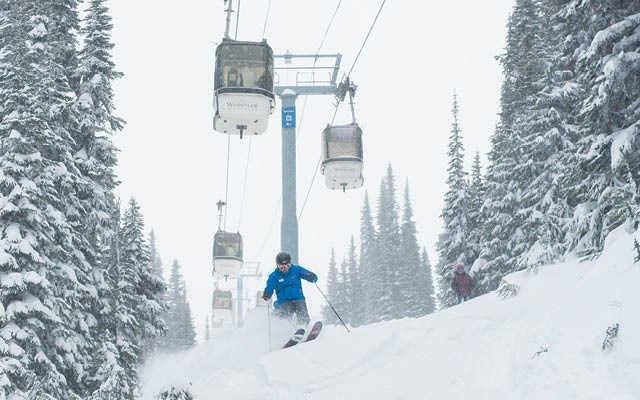Building on the installation of two new lifts this season, Whistler Blackcomb (WB) revealed another major capital investment Tuesday, Feb. 4 with the announcement of new eight-passenger gondola cabins for its Whistler Village Gondola.
The $6-million project will see the lift's current cabins, which have been loading guests since 1988, replaced with 160 eight-passenger cabins with more comfortable seating, reduced vibration and noise over lift towers and equipment storage space outside the cabin.
"You get into this cabin and the ride will be so far from what the experience is now that you'll feel like you're in a brand new gondola," said WB's vice president of planning, government and special projects, Doug Forseth. "The cabins that have been on the line since 1988 have done terrific work for us, but they've had their time out there, and it's like an older car with its shakes and rattles."
Although the current gondola can hold up to 10, the new eight-person cabins are expected to increase capacity by 12 per cent.
"The reality is we don't get 10 people in (the existing cabins) very often, and we're probably just shy of eight on average," said Forseth, who expects the new cabins will be at capacity the majority of the time.
The upgrades will also assist WB in moving single riders up the hill faster, Forseth noted, admitting that "the singles' line has been tough to manage with the current layout."
The original gondola will continue operating all summer before closing for four weeks in September and October for the installation of the new cabins ahead of the 2014-15 season. Improvements will also be made at the base of the Whistler Village Gondola, and at the Olympic and Roundhouse stations during this period to enhance the functionality of the interior spaces as well as the terminals' appearance.
Whistler Blackcomb will spend an additional $5.9 million on updating its information technology infrastructure, including installing a radio-frequency identification (RFID) system with lift access control gates at most mountain lifts — this is expected to drastically reduce lift ticket fraud and guest wait times.
"We now have people out there with scan guns, and if you walk up on a cold day like this and you've got your pass tucked inside you've got to unzip your jacket to get your pass out, and that can be uncomfortable," said Forseth, who added that the new technology, which is already commonly used throughout Europe, will give riders the ability to pass through main access points, as well as some mid-mountain and alpine lifts, without showing their pass.
Everyone will have to get a new pass.
"It should be a little faster, a little simpler and more comfortable for everybody," he added.
The RFID system will also give guests the ability to see what lifts they've been riding, as well as enable WB staff to track what areas riders are using.
"That will help us plan the ski area experience better," Forseth said. "If we have underutilized lifts, we'll look at what we can do to spread things out to make it a little more even."
The ski resort operator also reported its quarterly financials Tuesday for the three-month period ending Dec. 31. Whistler Blackcomb had to cope with a historically low snow season, with only 186 centimetres by year's end compared to 560 during the same period in 2012, and a 10-year average of 472 centimetres.
The result was a $400,000 drop in revenue to $49.8 million, and a decrease in adjusted Earnings Before Interest, Taxes, Depreciation and Amortization (EBITDA) of $800,000 to $9.5 million as a result of reduced visitation. The three-month period saw 426,000 total visits compared to 489,000 in the same quarter last year.
The loss amounted to 19 cents per share, compared with seven cents per share a year earlier, with the increase mostly due to non-operating items.
"We are pleased that our revenue and adjusted EBITDA held up in spite of the lower than expected visitation, which demonstrates our pricing power and the resiliency of our business," WB president Dave Brownlie said in the quarterly report.
The figures for revenue per visit were more promising, however, with a 14 per cent increase over last year, which reflected strong growth in effective ticket price and guest spending in WB's ancillary businesses.
As of Feb. 2, WB reported 846,000 skier visits this season, a nearly nine per cent drop from last winter. Destination visitors made up 40 per cent of total skier visits as of Feb. 2, according to WB estimates, up from 30 per cent for the prior year, with regional visitors making up the remainder.
Season pass and frequency card sales were also up from the 2012-13 season, with a three per cent increase to $41.4 million in sales as of Feb. 2.




